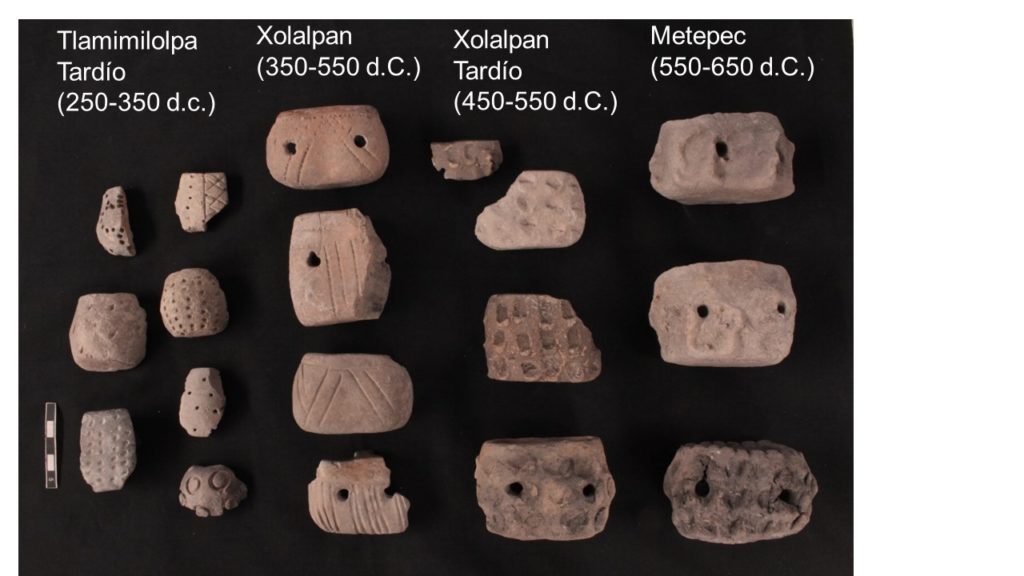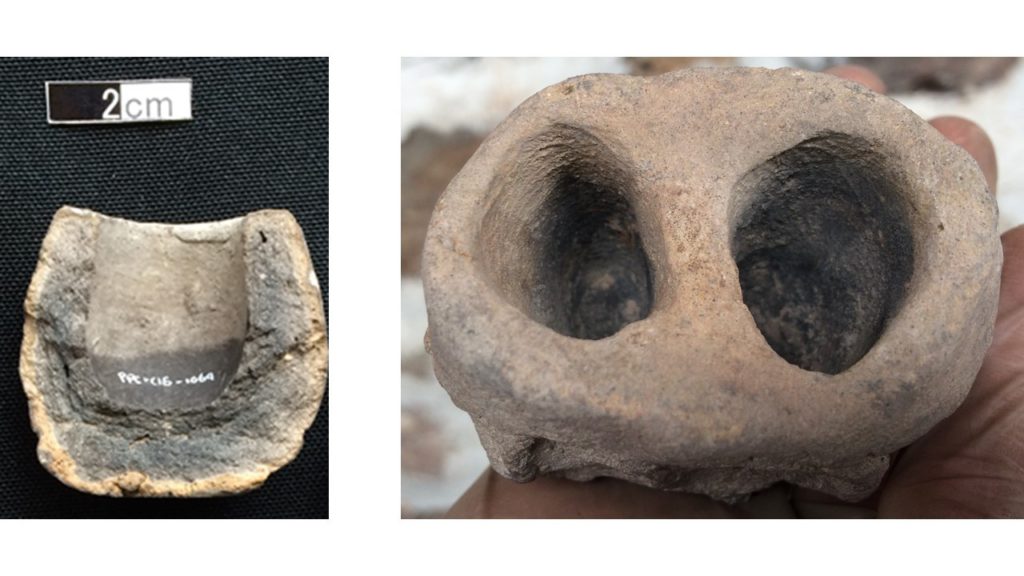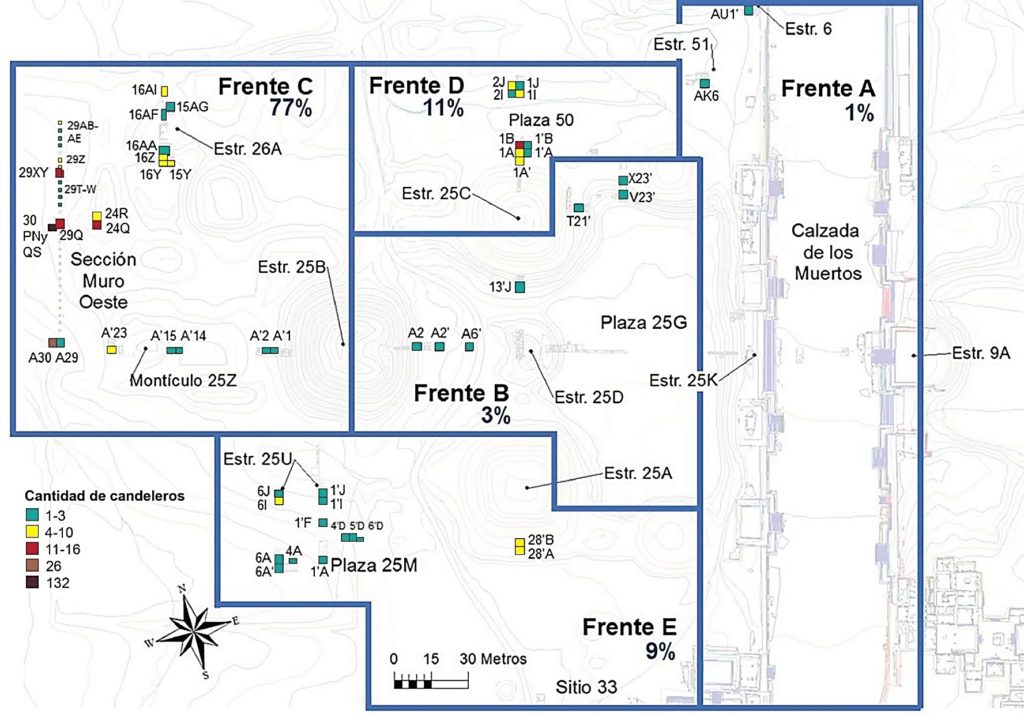What can be learned through pottery analysis?
The case of candeleros
by Yolanda Peláez Castellanos
The potters who made the ceramic pieces recovered in archaeological excavations gave them different shapes depending on the function they would have (e.g., pots and bowls were used in the preparation and consumption of food). A very distinct form that corresponds almost exclusively to Teotihuacan can be seen in the figure below; these vessels have been found in various foreign sites, and each have been attributed to Teotihuacan presence or influence.

These vessels are small and can have one (4x5x4cm) or two (5x8x5cm) cylindrical chambers, the latter usually having lateral perforations. In the Colony Period they were called candeleros (“candlesticks”) because the indigenous people reused them to support candles (Ceballos 1992: 205-206), but these did not exist when the city of Teotihuacan was inhabited.
The analysis of the candeleros gives us information about them (Peláez 2018):
PRODUCTION
– When examining the pieces, you can see the technique that was used to decorate them (e.g., punching, incision, fingerprints).
– More time was spent in the production of some pieces (e.g., it takes longer to manufacture a candelero with a polished lip like those of the Xolalpan phase than one with fingerprints like those of the Metepec phase).
– The method of making and decorating them has changed over time. Based on physical attributes, they were classified into three phases considering the parameters of an already established chronology (Rattray 2001). Accordingly, this indicated that the production of candeleros lasted for a period of approximately 400 years (250-650 AD). (See Ceramic Analysis, Relative Chronology)
USE
Some visible features give us clues about the use of the candeleros:
– The dark traces in the chambers indicate that something was burned inside them.
– Charred organic remains were found inside some of the tested chambers.

In order to determine the substances that these artifacts may have contained, their chemical residues were analyzed. These residues are stored in superficial pores where liquid or semi-liquid substances might have spilled. If this action (of use) was repeated or if a large amount of matter was deposited, some components present in these solutions can be identified (i.e., phosphates, carbonates, proteins, fatty acids, carbohydrates, and pH can also be measured) through tests called spot-tests (Barba et al. 2008: 721; Barba et al. 2014: 202-204). This type of methodology is also used for soil chemistry analysis (Barba et al. 1991).
Not all the candeleros demonstrated a discernible amount of residue, but the combination of components that were identified was interpreted as moderate combustion of cellulose, presence of substances of animal origin, and combustion of resins (Peláez 2018). This is consistent with the results of other investigations (Ortiz 2006).
DEPOSITION
The location where the materials were found in excavations sometimes corresponds to the place where they were discarded and not necessarily where they were used, although it is feasible that they were used in the vicinity and in various locations in Teotihuacan. In large part, the candeleros have been found associated with domestic spaces.
Most of the analyzed PPC candeleros (77%) came from Front C. It was originally hypothesized that this area was domestic, although so far only rooms have been found west of Mound 25Z and north of Structure 26A. The presence of candeleros supports the idea that this area could have been residential.

References
Barba, Luis, Roberto Rodríguez, y José Luis Córdova
1991 Manual de técnicas microquímicas de campo para la arqueología. Instituto de Investigaciones Antropológicas, Universidad Nacional Autónoma de México, México, D.F.
Barba, Luis
2008 Los residuos químicos en cerámica. Indicadores arqueológicos para entender el procesamiento de alimentos y el uso de recipientes. In Quaderni di Thule VIII. Atti del XXX Convegno Internazionale di Americanistica, pp. 721-728. Centro Studi Americanistici Circolo Amerindiano, Perugia.
Barba Luis, Agustín Ortiz y Alessandra Pecci
2014 Los residuos químicos. Indicadores arqueológicos para entender la producción, preparación, consumo y almacenamiento de alimentos en Mesoamérica. Anales de Antropología 48(1):201-239.
Ceballos Novelo, Roque
1922 Candeleros. En La población del valle de Teotihuacan, Vol. 1, edited by Manuel Gamio, pp. 205-212. Secretaría de Agricultura y Fomento, Dirección de Antropología, México, D.F.
Rattray, Evelyn
2001 Teotihuacan: cerámica, cronología y tendencias culturales. Instituto Nacional de Antropología e Historia and University of Pittsburgh, México D.F.
Ortiz, Nidia
2006 El candelero: estudio comparativo sobre su función en Teotihuacan durante el Clásico, Epiclásico y Posclásico Temprano. Tesis inédita de licenciatura en Arqueología, Escuela Nacional de Antropología e Historia, México, D.F.
Peláez Castellanos, Yolanda
2018 Los candeleros del Complejo Plaza de las Columnas, Teotihuacan. Tesis inédita de licenciatura en Arqueología, Universidad de las Américas, Puebla, Cholula, Puebla.